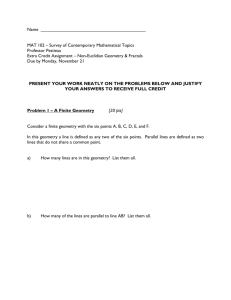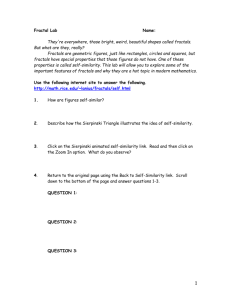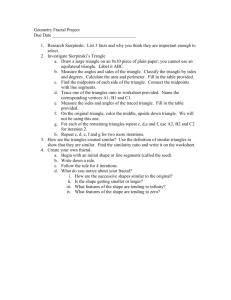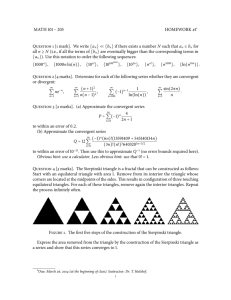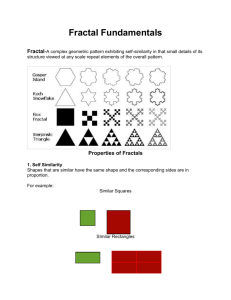Fractal Geometry 1 What Is a Fractal? Sarah Kitchen
advertisement
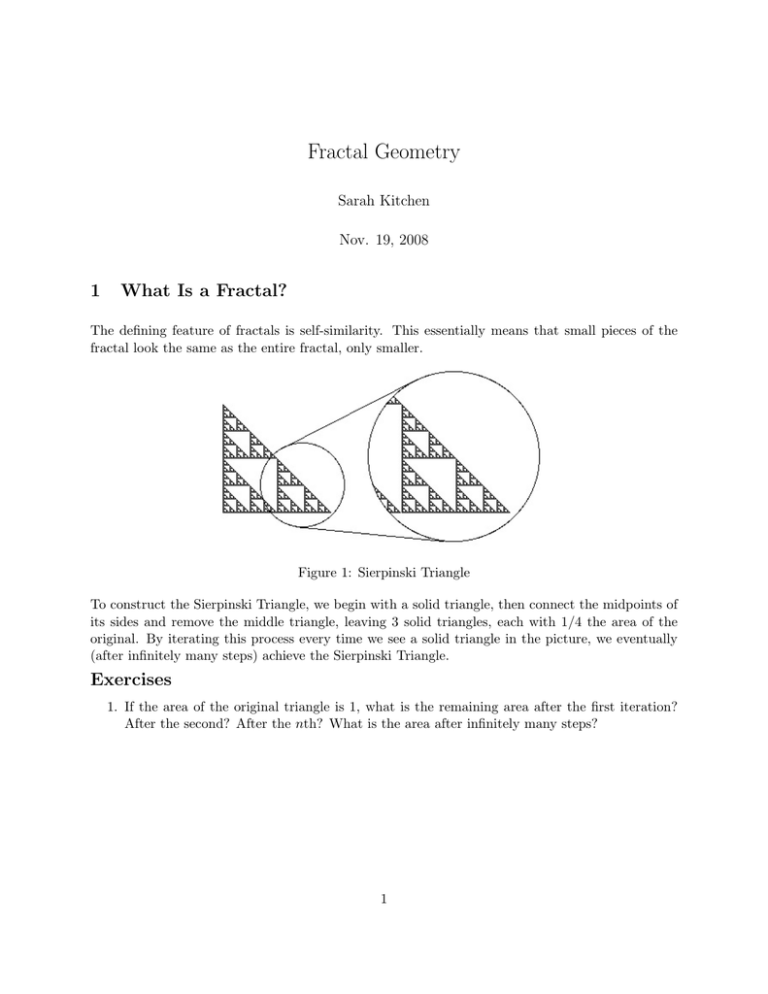
Fractal Geometry Sarah Kitchen Nov. 19, 2008 1 What Is a Fractal? The defining feature of fractals is self-similarity. This essentially means that small pieces of the fractal look the same as the entire fractal, only smaller. Figure 1: Sierpinski Triangle To construct the Sierpinski Triangle, we begin with a solid triangle, then connect the midpoints of its sides and remove the middle triangle, leaving 3 solid triangles, each with 1/4 the area of the original. By iterating this process every time we see a solid triangle in the picture, we eventually (after infinitely many steps) achieve the Sierpinski Triangle. Exercises 1. If the area of the original triangle is 1, what is the remaining area after the first iteration? After the second? After the nth? What is the area after infinitely many steps? 1 2. Similar to the Sierpinski Triangle is the Sierpinski Carpet: Figure 2: Sierpinski Carpet Describe the iteration used to construct this fractal. If the area of the solid square is 1, what is the area after the nth iteration? What happens when n goes to infinity? 2 Fractal Dimension What we see from these exercises is that while we started with a solid object (triangle or square), we ended up with an object with no area. So, even though we obtained these fractals by drawing shapes which have area, we effectively removed it all during our infinitely many iterations. Fortunately, there are other ways to measure. One of these ways is dimension. Points are zero-dimensional, lines are 1-dimensional, squares, triangles, and other shapes drawn in the plane are 2-dimensional, and solid objects like spheres and cubes are 3-dimensional. Since the Sierpinski fractals above were obtained by removing all the area from two-dimensional objects, are they still two dimensional, or are they now one-dimensional? What dimension should these fractals be? There are actually many different kinds of “fractal dimension” which are sometimes related, but may give more or less desired information, given a certain context. For example, consider the Koch Curve: Figure 3: Koch Curve This fractal is constructed by iterating the shape in Figure 4 on every straight-line segment. Each straight-line segment is 1/3 the length of the interval. 2 Figure 4: Koch Curve Generator The Koch Curve, being constructed from line segments rather than removing area, does not have the same dimensional ambiguity as the Sierpinski fractals. Indeed, the Koch Curve is 1-dimensional in our traditional sense, but as a fractal, one may consider this unsatisfying when comparing its dimension to that of other fractals. In fact, we should only compare dimensions between fractals by first fixing a type of fractal dimension that is defined on all the fractals we wish to compare. The dimension we will focus on today is the box-counting dimension. We will define this dimension for fractals which can be drawn in the plane. Place our planar object K in a box. Then, after dividing the box evenly into 22n sub-boxes, define N (n, K) to be the number of internal sub-boxes which intersect K. Figure 5 shows box-counting for Great Britain, although their box refinement is slightly different from ours. The darker squares are those which intersect Great Britain, and you can see that as the size of the internal boxes gets smaller, the darkened boxes take on an increasingly refined shape. Figure 5: Box-Counting Great Britain Then, to find the box-counting dimension dimbox K, take log2 N (n, K) n as n goes to infinity. For example, consider the box itself as K. Our usual notion of dimension 3 gives 2 as the dimension. For every refinement into 22n sub-boxes, all of the sub-boxes intersect K, so N (n, K) = 22n . Then, log2 N (n, K) log2 22n 2n = = = n, n n n so the box-counting dimension dimbox K = 2 as well. This is good because ideally fractal dimensions for objects which aren’t fractals should agree with the usual notion of dimension. Exercises 1. Compute N (n, K) for the Sierpinski Triangle. What is the box-counting dimension? Here is a copy of the triangle which you can draw on: Figure 6: Sierpinski Triangle 2. Sometimes 22n boxes does not give the most efficient computation of the box-counting dimension. For the Sierpinski Carpet, try computing the box-counting dimension with 32n boxes, taking log3 N (n, K) instead of log2 N (n, K). There is a copy of the Sierpinski Carpet on the next page. 3. (Challenge) Compute N (n, K) for the Koch Curve. What is the box counting dimension? Is base 2 or base 3 (or something else) the easiest way to compute the dimension? 4 Figure 7: Sierpinski Carpet Figure 8: Koch Curve 5 4. If you have extra time, try computing the box-counting dimension for these two fractals and compare your answers with the Sierpinski fractals. Figure 9: Problem 4 Figure 10: Problem 4 6 3 Constructing Fractals as Iterated Function Systems We can formalize the construction of the Sierpinski triangle by using iterated function systems. If K is the Sierpinski triangle, then it is made up of 3 smaller copies of itself. Figure 11: Sierpinski Triangle By putting the triangle in the coordinate plane, giving the base length 1 and setting the height equal to 1, we see the lower left triangle 1 Kll = K, 2 then, the lower right Klr and upper Ku triangles can be defined similarly as Klr = 12 K + ( 12 , 0) Ku = 21 K + ( 14 , 12 ). The union Kll ∪ Klr ∪ Ku of these three scaled copies of K again gives K. If we had started with a solid triangle, then by repeatedly applying these transformations infinitely many times, we would recover the Sierpinski Triangle. The fractal, then is the fixed point set of this transformation. This procedure can be generalized to allow all plane transformations, which are combinations of the following: • Scaling–Changing the dimensions of K by a fixed scale factor. • Reflection–Taking the mirror image of K across a line. • Rotation–Rotating K through some angle. • Translation–Shifting K left, right, up, down, or some combination, in the plane. If T is a plane transformation, then we call it a contraction if the scale factor is less than 1. An iterated function system is given by a collection of contractions T1 , T2 , . . . , Tn . If K is some object in the plane, let K1 = T1 (K) ∪ T2 (K) ∪ · · · ∪ Tn (K). We can further define Km iteratively as the union of Ti (Km−1 ). The limit set for the Km as m goes to infinity will be a fractal and the fractal will be invariant under this procedure. That is, by applying the Ti to the fractal and taking the union, we will again obtain the fractal. 7 Exercises 1. Describe the Sierpinski Carpet and Koch Curve by iterated function systems. 4 Mandelbrot and Julia Sets The idea of iterating functions can be extended to functions which are not necessarily plane tranformations. Let (x0 , y0 ) and (a, b) be pairs of real numbers. Consider the recursive formulas xi+1 = x2i − yi2 + a (1) yi+1 = 2xi yi + b. (2) If the point (xn , yn ) stays in some bounded region in the plane for n very large, then the point (x0 , y0 ) belongs to the filled-in Julia set K(a,b) for (a, b). A Julia set J(a,b) is the boundary of K(a,b) . Here are some examples Julia sets: Figure 12: Julia Sets 8 Filled-in Julia sets are usually colored very nicely: Figure 13: A Filled-in Julia Set Using the same recursive functions, we can define the Mandelbrot set, by fixing (x0 , y0 ) = (0, 0), and looking at (a, b) for which the points (xn , yn ) don’t diverge to infinity as n gets large. The resulting set of points in the plane have fractal boundary: Figure 14: The Mandelbrot set Exercises 1. Compute the first few iterations in the Julia set recursion for some choices of (a, b). Can you guess some values of (x0 , y0 ) in the filled-in Julia set? 9 2. Suppose the iteration were xi+1 = x3i − 3xi yi2 + a (3) 3x2i yi (4) yi+1 = − yi3 + b. Answer the same questions as in Problem 1. 5 For More Information Yale University has an extensive website on Fractal Geometry, written in part by Benoit Mandelbrot himself. Much of the information and pictures used in this talk came directly from this site: http://classes.yale.edu/fractals/ 10
